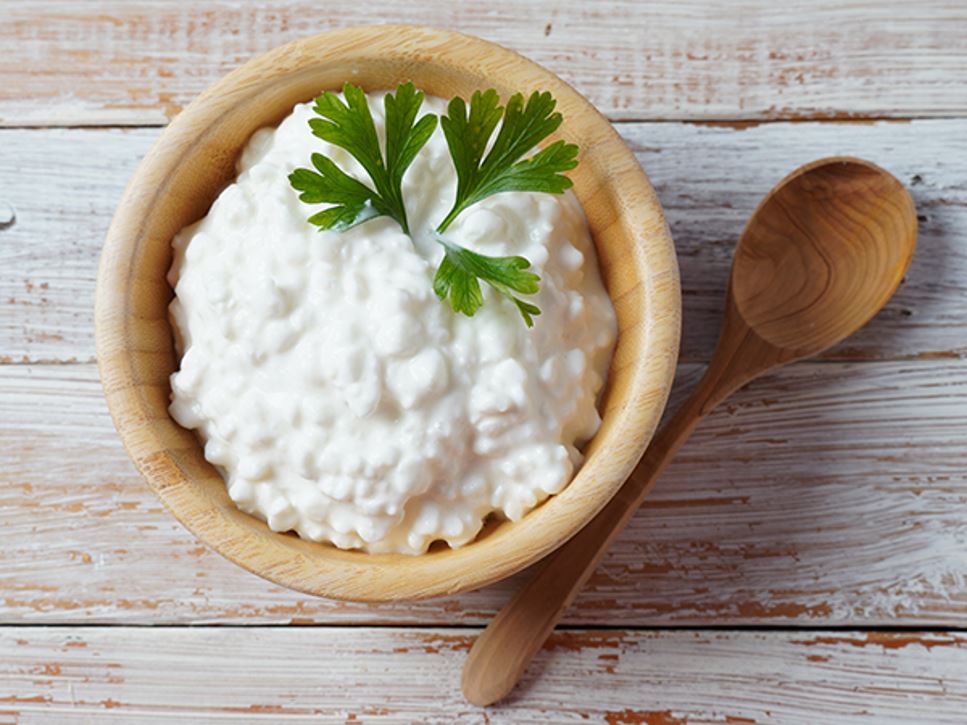Packed with protein, cottage cheese is a soft, fresh cheese. The tangy flavor of the fresh curds can be enjoyed as is, with added savory or sweet toppings or even as an ingredient in other dishes.
Cottage cheese is made by adding an acid, such as vinegar or a probiotic culture, to milk in order to separate the curds (solid) from the whey (liquid). The curds are then cut into large or small pieces and cooked to release moisture. Rinsing and draining then removes even more liquid and decreases the acidity. Cottage cheese curds are generally salted. Often cream or thickeners are added for a creamy texture.
Types of Cottage Cheese
- Percentage of fat. Fat-free, 1% and 2% fat cottage cheese have less saturated fat and fewer calories than the 4% fat variety, which includes cream. Lower fat varieties also generally have slightly more protein.
- Large curd or small curd. Large curd cottage cheese tends to be higher in moisture than small curd cottage cheese, so it may be perceived as tasting creamier and sweeter than the latter, but this is not necessarily true. Small curd does, however, tend to taste slightly tangier and more acidic.
- Whipped. This smooth-textured cottage cheese is spreadable.
- Dry curd or farmer cheese. Cottage cheese curds are allowed to drain longer so they become dry, firm and form a dense cottage cheese also known as farmer cheese.
- Probiotic. To obtain these beneficial bacteria, cottage cheese products that contain probiotics must have the container labeled as having “live and active cultures.”
- Lactose-free. This type of cottage cheese is free of lactose, which is found in the whey of milk and other dairy products. Much of the whey is drained out of cottage cheese, making it naturally lower in lactose than milk. Some people with lactose intolerance can eat cottage cheese with few symptoms.
- Flavored. Cottage cheese is sold plain or flavored. Check the label for added sugars, which are often present with fruit-flavored varieties.
I bought cottage cheese. Now what?
- Sprinkle it. Make a savory cottage cheese bowl by topping a serving with savory spices such as cumin and black pepper, along with nuts or a drizzle of tahini.
- Spread it. For breakfast or lunch, spread it on whole-grain toast and top with brightly colored fruit such as berries or slices of kiwi or avocado.
- Mix it. Instead of using mayonnaise, make egg salad or tuna salad with cottage cheese. Serve on a big bed of greens.
- Scoop it. For a protein boost, scoop cottage cheese onto a bowl of cooked rice, pasta or oatmeal; swirl it into eggs before scrambling; or top pancakes with cottage cheese and fresh fruit or fruit canned in 100% juice.
- Dip it. Use cottage cheese as an ingredient for a creamy dip like this recipe with customizable flavors. Prevent food waste by adding leftovers from the fridge: make a sweet dip sweet by blending in ripe fruit and a drizzle of honey. Or, go savory with whatever herbs you have on hand or green onions. Serve with whole-grain crackers or flatbread.
- Use as a paneer substitute. Paneer is a style of cottage cheese originating in India. Cottage cheese may be used as a substitute for paneer in dishes such as curry, masala and more.
- Blend it. Once blended, cottage cheese has the consistency of yogurt or sour cream, but with a less tangy taste. Use it in chocolate pudding, vanilla ice cream and blueberry smoothies.
- Cook or bake with it. For recipes such as lasagna or stuffed shells, cottage cheese is often listed as a substitute for ricotta cheese. Some breads and muffins also may include cottage cheese as a protein-rich ingredient.
Cottage Cheese Nutrition Information
One-half cup is the serving size often listed on the Nutrition Facts panel, but snack-sized cups of cottage cheese are usually 5 to 6 ounces.
Because cottage cheese is lower in calcium compared to other dairy products, including milk and yogurt, 2 cups of cottage cheese counts as a 1-cup serving in the dairy food group of MyPlate. Cottage cheese is considered high in sodium, but there are lower sodium versions available.
A ½-cup serving of 2% fat cottage cheese (not low-sodium) contains approximately:
- 85 calories
- 4 grams carbohydrates (as the natural milk sugar lactose, and 0 grams added sugars)
- 11 grams protein
- 2.5 grams total fat
- 1.3 grams saturated fat
- 18% daily value (DV) sodium
- 2% DV potassium
- 8% DV calcium
- Other essential vitamins and minerals including phosphorus, magnesium and vitamin B12; unlike milk, cottage cheese is not generally fortified with vitamins A and D.
A ½-cup serving of cottage cheese has about double the amount of sodium of a (1-ounce) serving of hard cheese, such as cheddar. However, cottage cheese typically has 1.5 times the protein of hard cheeses, less saturated fat and five times more potassium. Additionally, eating cottage cheese with potassium-rich fruits and vegetables may help offset or limit the effect of sodium on blood pressure.
Find a Nutrition Expert
Looking for credible nutrition information and recommendations? The Academy of Nutrition and Dietetics' network of credentialed food and nutrition practitioners are ready to help!

